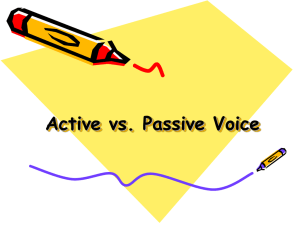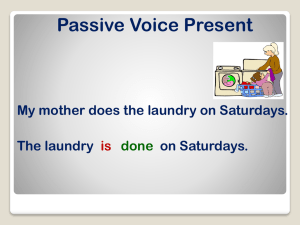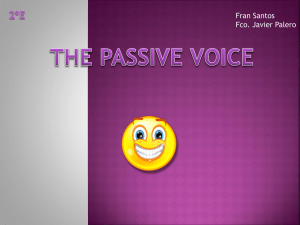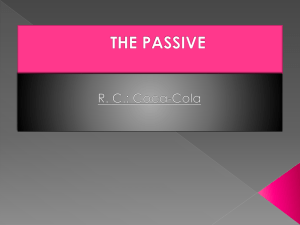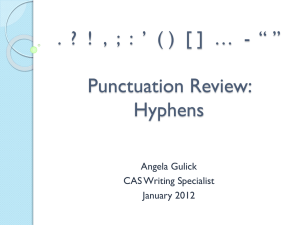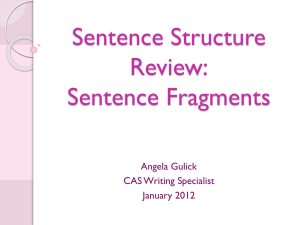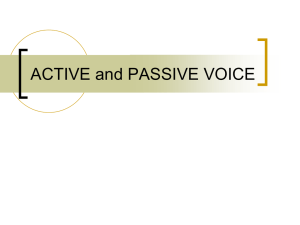Active and Passive Voice
advertisement
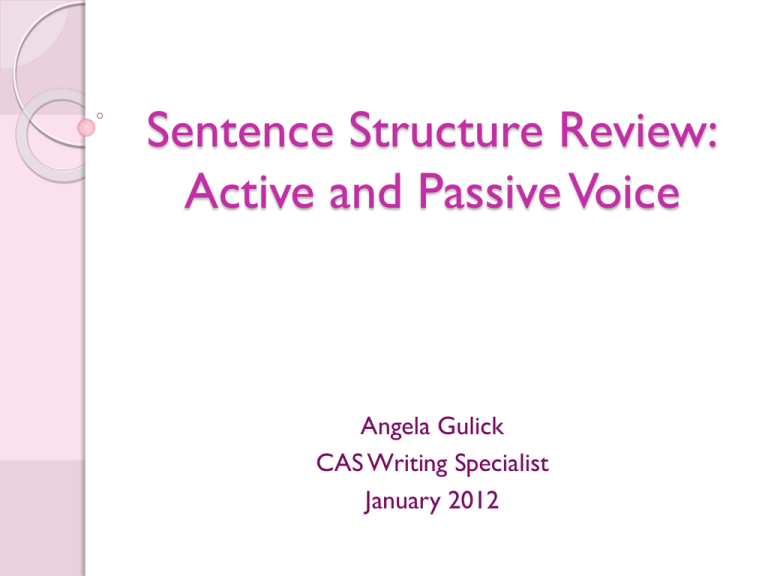
Sentence Structure Review: Active and Passive Voice Angela Gulick CAS Writing Specialist January 2012 Introduction This workshop provides a general overview that readers can go through at their own pace. The workshop does not cover every detail but focuses on the general rules associated with grammar, punctuation, and mechanics issues. A list of all Writing Lab handouts, PowerPoint workshops, and videos is available on the Center for Academic Success Resources page. A list of online exercises and additional sources is available at the end of this presentation. Copyright Angela Gulick, January 2012 What Exactly Are Active and Passive Voice, Anyway? If you feel silly that you don’t know the answer to this question, I would estimate that about 70% of the people I teach don’t know the answer either. Active and passive voice describe the order of information in a sentence and what is being focused on, the subject of the action, the action itself, or the receiver of the action. In most cases, a thought can be expressed both in the active and the passive voice. In some lines of work, active voice is encouraged. In other lines of work, passive voice is encouraged. IMPORTANT: Passive voice is not the same as past tense. This is a very common error. So let’s get these two figured out. Copyright Angela Gulick, January 2012 Active Voice Active voice means that the subject or “actor” of the sentence is performing the action of the sentence.The actor will generally appear very early in the sentence. If you think back to stories you were told as a child, they were written in active voice Examples of Active Voice: The cow jumped over the moon. (actor = the cow) And they all lived happily ever after. (actors = they) Mary had a little lamb. (actor = Mary) My brother broke the window. (actor = my brother) The bouncer threw the drunken patron out of the (actor = the bouncer) restaurant. Copyright Angela Gulick, January 2012 Active Voice Active voice is generally encouraged because readers clearly can see who or what is doing the action. Also, active voice is a bit more concise than passive voice. For example, if you are providing eye-witness testimony to an accident and you are speaking to a police officer, you want to focus on what you saw and experienced personally. I saw… I called… I helped… Copyright Angela Gulick, January 2012 Passive Voice On the other hand, passive voice focuses not on who is doing the action but on the action itself. In some cases, the focus is on the recipient of the action. Notice how in the following examples, the “actor” that was at the beginning of the active voice sentences is now at end of the passive voice sentences: Active Voice:The cow jumped over the moon. Passive Voice: The moon was jumped over by the cow. Active Voice: And they all lived happily ever after. Passive Voice: Life was lived happily by all of them. Active Voice: Mary had a little lamb. Passive Voice: A little lamb was owned by Mary. Active Voice: My brother broke the window. Passive Voice: The window was broken by my brother. Active Voice:The bouncer threw the drunken patron out of the restaurant . Passive Voice: The drunken patron was thrown out of the restaurant by the bouncer. A good clue you have passive voice: the phrase “by ____________” is at the end of the sentence (by the cow, by all of them, by Mary, by my brother, my the bouncer.) Copyright Angela Gulick, January 2012 Passive Voice In some cases, readers are never told who actually performed the action at all. Let’s rewrite these examples one more time: The moon was jumped over. (by whom?) Life was lived happily. (by whom?) A little lamb was owned. (by whom?) The window was broken. (by whom?) The drunken patron was thrown out of the restaurant. (by whom?) How about this one: The toddler was left unattended with a bunch of Crayola markers. (by whom?)* *Seriously – who did this? Copyright Angela Gulick, January 2012 Passive Voice It is appropriate, and even customary, to use the passive voice when the performer of the action is less important than the action and/or the recipient of the action. For example, in many types of scientific writing, passive voice is widely used: “Twenty-five milliliters of hydrochloric acid were poured into the beaker by the scientist” or “Twenty-five milliliters of hydrochloric acid were poured into the beaker.” Notice we don’t write, “The scientist poured twenty-five milliliters of hydrochloric acid into the beaker.” In this case, readers don’t really care about who did the action in the experiment; the focus is on the action itself. Copyright Angela Gulick, January 2012 Passive Voice Sometimes, passive voice is used to obscure who is responsible for the action being described, and this can, on occasion, be unethical: The window was broken. (by whom?) Is it ethical to leave the actor out when the actor is known, such as in “The window was broken by my brother”? Or better yet, “My brother broke the window”? Mistakes were made. (by whom?) Is it ethical to leave the actor out when the actor is known, such as in “Mistakes were made by Angela when she gave the dog a tube of dark purple lipstick to play with”? Or better yet, “Angela gave the dog a tube of dark purple lipstick to play with”? Ask yourself which sentences most clearly state who did the actions being described. Note:This is not my dog, and I did not give her dark purple with on the white livingroom carpeting. I found this image on the internet. Mistakes were made… lipstick to play However, I am fully capable of doing some thing this stupid with my own dog. Copyright Angela Gulick, January 2012 Which Voice Should You Use: Active or Passive? Most English teachers recommend using active voice because it is more direct, more concise, and the actor of each sentence is very clear. Notice that passive voice just takes longer to read: ◦ Passive voice: The window was broken by my brother. (7 words) ◦ Active voice: My brother broke the window. (5 words) ◦ A two-word difference doesn’t seem like much. However multiply this by a 20page report, and this more wordy writing style can have a negative impact on the reader. Most scientists recommend using passive voice because the focus is on the actions within the experiment. No one really cares who is performing the experiment, only the methods and results of the experiment. My advice: Use active voice unless you’ve specifically been told that passive voice is used in your class, career, or workplace. Copyright Angela Gulick, January 2012 Do You Still Have Questions? If you still have questions, please stop by the Writing Lab (D120) or check out our list of writing workshops on the CAS Resources page. Here are additional websites that can help you with grammar, punctuation, and mechanics issues. The first two links with ’s also have online exercises with answer keys to help you practice. Grammar Bytes Note: This site might require you to download a small program onto your computer the first time you use it. Guide to Grammar and Writing Purdue Online Writing Lab (OWL) Grammar Girl The Blue Book of Grammar Copyright Angela Gulick, January 2012


